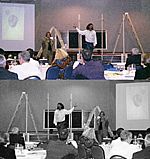


A note from
Gary Brewer (LINC Entomology faculty participant at NDSU) to the
Deptarment of Fine Arts:
I feel I have done a poor job of explaining LINC and where we want to go. LINC is a Kellogg's funded project that looks at leadership issues around the topic of engagement.
As a group we have struggled with what engagement is and have not come up with a precise definition. But we have agreed on characteristics of engagement. Engagement is a true partnership, which means that all partners contribute resources (more than just money) and all influence the process and outcome. With engagement there is trust and intimacy.
We have also agreed that engagement is a spectrum, not a particular place. Engagement ranges from little "e" to big "E". The more the engagement traits are present, the larger the "E" the more engaged the interaction or partnership.
You have described us as asking for the moon, and I suppose we are. That is why we need your help and collaboration on this project to bring it to reality. We trust you to help define the process and outcome to make it feasible.
Public art, as I understand it, does not simply mean placing art in a public space although an artistic creation resulting from the public art process would certainly be situated in a public space.
My understanding of art is that art ("standard" arts practice) is an expression of the artist, it is the communication of the artist's experiences and emotions. It is the artist's view and outlook creatively worked and expressed. In public art, the artist's view is less prominent; instead the artist captures and expresses the views, experiences, and emotions of the different publics. In this way public art participates in a civic dialogue. It expresses the give-and-take between communities around important issues. The issues LINC is interested in are Engagement and Life-Long Learning.
An artist functioning as a public artist will meet with the groups concerned in a safe environment where everyone can honestly express their stories and concerns, listen to others, and learn from each other. The public artist facilitates this approach by using the creative artistic process to help the groups understand and respect their uniqueness and creativity. This is where the metaphor of a bridge came from that Karl Lorenz is using as a framework for his facilitation. He is using the metaphor of "bridge" and" bridging" to help us span the various ideas and concerns of our diverse communities and allow everyone to experience a variety of views. He is building a series of "bridging" panels to document our insights and processes.
Big "E" engagement as is not necessarily how we are used to working. We are interested in having a public artist explore engagement at NDSU. It is our hope that the artistic process can help bridge the ideas and misconceptions regarding engagement. NDSU has lots of examples of engagement, but they are most likely to be with communities we are comfortable with, that are like us.
For example, in agriculture we engage commodity groups. Together we discuss issues and provide resources to resolve problems. NDSU engages K-12 teachers in solving education issues. There are classes on campus where there is engagement between the instructor and students, between the class and industry, and between classes.
In situations where the communities are less like us, engagement occurs less often and is less likely to succeed. How often and how successful are we in interacting with and partnering with Native American groups, immigrant groups, or non-Northern European groups?
LINC has come to you with an idea, some resources, and a (poorly defined) problem, is NDSU meeting its land-grant mission to engage the citizens of North Dakota? We are asking you to partner with us in this project. As a partner in the sense of big "E" engagement we ask that you contributing resources; ideas, concepts, approaches, physical space, and support from your unit. The idea is already different because of the involvement of you and Wayne. This is building engagement.
An approach (this is my view) to this project would be to look at the engagement spectrum at NDSU: engagement with similar communities and engagement with more dissimilar groups. The ideas and experiences could then be used to develop an artwork that celebrates our successes and points out what we still need to do.
We also talked about having the public artist assist with the life-long learning project. As you pointed out, this may be too much. As way of background, we see life-long learning as a NDSU objective that is shared by agriculture. A typical approach to life-long learning would be for us to put a program together and deliver it. If we are successful, people will use it. Another approach would be to talk to people in Beach, Williston, and other communities and learn what their ideas of life-long learning are and how do they differ from our ideas. Then together we would build a program.
Hopefully, I have not confused you even more. Take care.
Gar